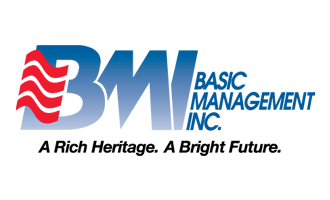Basic Management, Inc. (BMI) is proud of the significant role this site has played in history. It has helped a nation protect its freedom; provided thousands of jobs; played a significant role in the creation of Henderson, Nevada; contributed to the global and local economy; helped put man on the moon; and provided products that have made our lives easier and safer. Companies associated with BMI have pioneered such products as lightweight titanium metal, chlorine for water disinfection and manganese, the dry cell energy source in batteries.
BMI has proven to be a leader on many fronts and continues to do so with its voluntary effort to restore and redevelop land that was used for many years to make a difference in our lives.
Basic Magnesium & Henderson
 From Basic Street to Basic High School, signs of the past remain in fast-growing Henderson. The names refer to the World War II era Basic Magnesium complex southeast of downtown Henderson - the largest magnesium plant in the world at the time.
From Basic Street to Basic High School, signs of the past remain in fast-growing Henderson. The names refer to the World War II era Basic Magnesium complex southeast of downtown Henderson - the largest magnesium plant in the world at the time.
In 1941, the Basic Magnesium Inc. complex was built by the Anaconda Copper Company for the Federal Government to produce magnesium - the lightest and strongest of metals - that was suddenly needed in large supply to build airplane bodies and other materials critical to the Allied war effort during World War II.
More than 13,000 men and women flocked to the desert site to work on the project, many from areas of the country still mired in the Great Depression. This gave birth to Henderson, which is now the second largest city in Nevada.
Las Vegas in 1941 was a tiny railroad watering station. The site was chosen for its proximity to Lake Mead for water, the Hoover Dam for power, and Gabbs for its deposits of magnesite. The 5,000-acre site previously was barren desert.
- There was no water at the site. A large water intake station, pumphouses, pipelines and reservoirs had to be installed to bring water from Lake Mead over the River Mountains and some 20 miles to the plant site.
- There was no power at the site. Huge electric lines were required from Hoover Dam to the facility.
- There were no local services. Houses, schools, a hospital, stores, markets, a post office, a fire department, churches, sewage facilities, and the like all had to be built.
- There were no processing facilities. Facilities to mine and process the magnesite ores had to be constructed.
- There were no railroads. A railroad line to transport the prepared ores from Gabbs to the magnesium plant had to be built.
These magnesium production facilities would encompass a massive complex approximately two miles in length, and which eventually would include a chlorine plant, ore preparation plant, chlorination plant, metals recovery plant, an electrolysis plant, as well as the support facilities for each. The manufacturing facility - the largest of its kind - and all of its support facilities was completed from scratch in the astonishing time of just 11 months.This was done under conditions hard to imagine today and at a cost of $130 million.
The Basic Magnesium complex made its presence felt in many ways. The settlement that housed and provided for many of the workmen and their families, called Basic Townsite, would become the core of Henderson. The plant's weekly payroll of $1 million enriched local businesses.
By 1944, the Allies' need for magnesium dwindled, the plant stopped production and was shut down. Though thousands of people left the region, enough remained to save the settlement. In 1953, behind the efforts of some civic-minded settlers, Basic Townsite and the neighboring town of Pittman incorporated as the City of Henderson, named in honor of former Nevada U. S. Senator Charles B. Henderson.
Basic Management & Affiliates
 After the plant was shut down by the federal government in late 1943, the U.S. War Asset Administration actually offered Henderson for sale as war surplus property in 1947. In an effort to save the city, the Nevada Legislature spent a weekend visiting Henderson evaluating the possibility of state administration of Basic Magnesium. Within days of the visit, the legislators unanimously approved a bill giving the Colorado River Commission of Nevada the authority to purchase the industrial plants for $24 million with $1 as a down payment and the balance to be paid from leasing the facilities to private industries. The bill was signed on March 27, 1947.
After the plant was shut down by the federal government in late 1943, the U.S. War Asset Administration actually offered Henderson for sale as war surplus property in 1947. In an effort to save the city, the Nevada Legislature spent a weekend visiting Henderson evaluating the possibility of state administration of Basic Magnesium. Within days of the visit, the legislators unanimously approved a bill giving the Colorado River Commission of Nevada the authority to purchase the industrial plants for $24 million with $1 as a down payment and the balance to be paid from leasing the facilities to private industries. The bill was signed on March 27, 1947.
The Basic Magnesium Inc. complex was divided and privatized by Nevada. In May 1952 the entire divided complex was sold to several leading American manufacturers. They each owned the land upon which their particular manufacturing facilities were located. A new and separate company called Basic Management Inc. (BMI) was created to own and manage the assets that would be used in common by the manufacturing companies, including a water pipeline and distribution system, power distribution facilities, railroad facilities and evaporation ponds and several thousand acres of land.
BMI for nearly a quarter century, was the sole provider of water to the city of Henderson and the city of Las Vegas. The water delivery system contains 16 miles of pipeline, an intake structure at Saddle Island on Lake Mead, storage reservoirs and booster pumping facilities. To this day through a subsidiary of BMI, Basic Water Company, the system still delivers water from Lake Mead to the manufacturing companies, the City of Henderson and the Nevada Fish Hatchery. It has never missed a day's delivery.
The sleepy little industrial town of Henderson grew up around the manufacturing plants, which were the community's largest employers for decades. The manufacturing plants operating in the complex have made significant industrial contributions. Work began in the early 1950s by Titanium Metals Corporation (TIMET) on a revolutionary new ultra-light metal called titanium. It has been used largely in airplanes, but there are a myriad of applications including human replacement joints, sporting goods and jewelry. Kerr McGee, now known as Tronox, produced ammonium perchlorate, the rocket fuel that propelled the Space Shuttle into orbit. Although Tronox no longer produces ammonium perchlorate, it produces manganese dioxide which is used in dry cell batteries. Ohlin Chlor Alkali, also located within the complex, continues to produce chlorine which is an essential building block for the world's commercial chemistry, including pharmaceuticals, plastics and water disinfection.
In 1992, a subsidiary of Basic Management Inc., The Landwell Company, was created to develop land that had been held by BMI since 1952.
In 1999, another subsidiary was created, Basic Remediation Company, LLC., with its sole purpose to carry out the restoration of the 2,200 acres east of Boulder Highway.
Basic Remediation Company
 What is Basic Remediation Company?
What is Basic Remediation Company?
Basic Remediation Company is a wholly owned subsidiary of Basic Management, Inc. that has carried out remediation and restoration of the 2,200 acre site east of Boulder Highway.
The LandWell Company
 What is The LandWell Company?
What is The LandWell Company?
The LandWell Company is a land development company known for its successful redevelopment projects in southern Nevada, including Black Mountain Industrial Center, Valley Auto Mall and the Traverse Point Mixed Use Development. The LandWell Company is a limited partnership, affiliated with Basic Management, Inc. and is based in Henderson. The LandWell Company has been developing land for more than two decades. Since 1991, it has successfully developed more than 1,200 acres of retail, light industrial, commercial and residential projects in and around Henderson.
